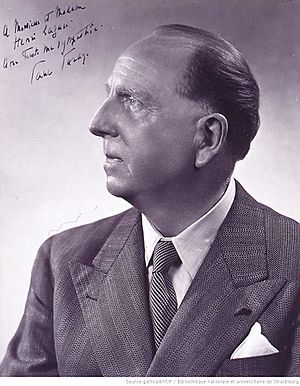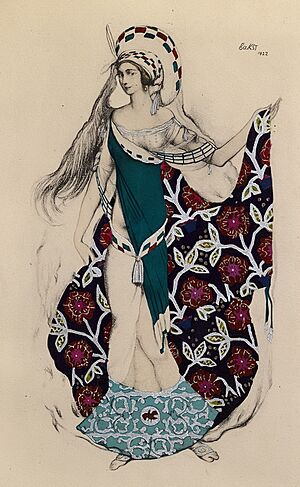Paul Paray facts for kids
Paul Marie-Adolphe Charles Paray (born May 24, 1886 – died October 10, 1979) was a famous French conductor, organist, and composer. He was the main conductor for the Detroit Symphony Orchestra from 1952 to 1963.
Contents
Paul Paray's Early Life and Music Training
Paul Paray was born in Le Tréport, Normandy, France. His father, Auguste, was a sculptor, an organist at St. Jacques church, and led a local music group. Young Paul started playing the drums in his father's group. Later, Paul went to Rouen to study music with special teachers and learned to play the organ. This training helped him get into the famous Paris Conservatoire, a top music school.
Paul Paray's Amazing Music Career
In 1911, Paul Paray won the top prize, the Prix de Rome, for his cantata called Yanitza. A cantata is like a short opera or play set to music.
During World War I, Paray was a prisoner of war. Even without paper, he composed a string quartet and a piano suite in his mind. He wrote them down from memory after the war ended. After the war, he was asked to conduct an orchestra in the Pyrenees mountains. This opportunity helped him get invited to conduct orchestras in Paris, which was a big step in his career.
Later, Paray became the music director of the Monte Carlo Orchestra. In 1922, he wrote music for a ballet called Artémis troublée. That same year, he and violinist Manuel Quiroga performed his Violin Sonata for the first time. In 1931, Paray wrote a special mass to celebrate 500 years since the death of Joan of Arc. This piece was first performed in the cathedral in Rouen.
Paray became the president of the Concerts Colonne, a famous concert series. In 1935, he wrote his Symphony No. 1 in C major, which was first played there. Paul Paray first conducted in America with the New York Philharmonic-Symphony Orchestra in 1939. He composed his Symphony No. 2 in A major in 1941.
In 1952, Paray became the music director for the Detroit Symphony Orchestra. He led them in many recordings for the "Living Presence" series by Mercury Records. Paray left Detroit in 1963.
After returning to France, Paray continued to conduct orchestras around the world. He was in his nineties when he conducted for the last time in the United States. He led the Orchestra of the Curtis Institute of Music in Philadelphia. A music magazine noted that at 92, Paray still had great strength, energy, and skill as a conductor.
Awards and Special Honors
Paul Paray was a National Patron of Delta Omicron, a music group for professionals. In 1975, the French government gave him its highest honor, the Grand-Croix de la Légion d'honneur.
Paul Paray's Personal Life
Paul Paray joined the French Army during World War I. In 1914, he was captured and held as a prisoner of war in a camp in Germany.
He married Yolande Falck in Cassis, France, on August 25, 1942. Paul Paray passed away in Monte Carlo in 1979, at the age of 93.
Paul Paray's Musical Works
- Stage
- Yanitza, a lyrical scene based on an Albanian legend (1911)
- Artémis troublée, ballet for Ida Rubinstein (1911–1912)
- Orchestral
- Symphonie d'archets for string orchestra (1919)
- Nocturne for chamber orchestra
- Symphony No. 1 in C major (1934)
- Symphony No. 2 in A major (1936)
- Concertante (for soloist and orchestra)
- Fantaisie for piano and orchestra (1909)
- Humoresque for violin and chamber orchestra (1910)
- Chamber music (for small groups of instruments)
- Piano Trio (1905)
- Sérénade for violin (or flute) and piano (1908)
- Sonata in C minor for violin and piano (1908)
- Humoresque for violin and piano (or chamber orchestra) (1910)
- Nocturne for violin (or cello) and piano (1910)
- String Quartet in E minor (1919)
- Sonata No. 1 in B♭ major for cello and piano (1919)
- Sonata No. 2 in C major for cello and piano
- Piano music
- Tarantelle
- Scherzetto
- Impromptu
- Vertige
- Incertitude
- Entêtement
- Berceuse
- Valse-caprice (1906)
- Romance (1909)
- Portraits d'enfants (1910)
- Valse sur un thème de Franz Schubert (1911)
- Impressions (1912)
- Reflets romantiques (1912)
- Sept pièces (1913)
- Presto (1913)
- Prélude, scherzo et allegro
- Thème et variations (1913)
- Prélude in F major (1913)
- Allegro (1913)
- Scherzo (1913)
- D'une âme... (1914)
- Pieces for piano 4-hands (1914)
- Éclaircie (1923)
- Prélude (1930)
- Allegretto
- Prélude en mi bémol mineur
- Prélude en fa mineur
- Sur la mer
- Valse en fa dièse mineur
- Valse en fa mineur
- Vertige
- La vraie furlana
- Vocal music (for voice)
- Nuit d'Italie for voice and piano
- Laurette for voice and piano
- Sépulcre for voice and piano
- Paroles à la lune for voice and piano (1903)
- Panis Angelicus for voice and cello (1904)
- Dans les bois for voice and piano (1904)
- La Promesse for voice and piano or orchestra (1910)
- La Plainte for voice and piano or orchestra (1911)
- Le Papillon for voice and piano or orchestra (1911)
- Le Champ de bataille (1912)
- Trois Mélodies for voice and piano or orchestra (1912)
- Villanelle for voice and piano or orchestra (1912)
- Chanson violette for voice and piano or orchestra (1913)
- Le Chevrier for voice and piano or orchestra (1913)
- Il est d'étranges soirs for voice and piano or orchestra (1913)
- Viole for voice and piano (1913)
- In manus tuas for voice, oboe and organ (1914)
- Quatre poèmes de Jean Lahor for voice and piano or orchestra (1921)
- Vocalise-étude for medium voice and piano (1924)
- Le Poèt et la muse for voice and piano
- L'Embarquement pour l'idéal for voice and piano
- Mortes les fleurs for voice and piano
- Chanson napolitaine for voice and piano
- Choral music (for choirs)
- Os Justi, Offertorium for chorus and organ (1903)
- Acis et Galatée, Cantata (1910)
- Jeanne d'Arc, Oratorio (1913)
- Salve Regina for chorus a cappella (1929)
- Messe du cinquième centenaire de la mort de Jeanne d'Arc (Mass for the Fifth Centenary of the Death of Joan of Arc) for soloists, chorus and orchestra (1931)
- Nuit tombante for chorus and orchestra
- Pastorale de Noël for soloists, chorus and orchestra
- Soleils de septembre for chorus and orchestra
See also
 In Spanish: Paul Paray para niños
In Spanish: Paul Paray para niños



